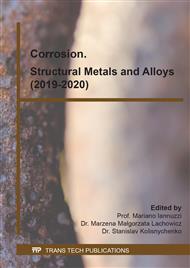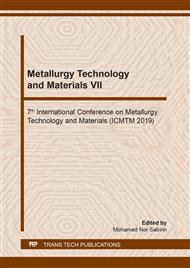[1]
J. Elvins, J.A. Spittle, J.H. Sullivan, The effect of magnesium additions on the microstructure and cut edge corrosion resistance of zinc aluminium alloy galvanised steel, Corros. Sci. 50(2008) 1650-1658.
DOI: 10.1016/j.corsci.2008.02.005
Google Scholar
[2]
L. Suarez, F. Leysen, C. Masquelier C, D. Warichet, Y. Houbaert, Effects of Mg additions on surface morphology and corrosion resistance of hot-dipped Zn coatings, Defect and Diffusion Forum, 273-276(2008) 300-305.
DOI: 10.4028/www.scientific.net/ddf.273-276.300
Google Scholar
[3]
J. Tanaka, K. Ono, S. Hayashi, K. Ohsasa, T. Narita, Effect of Mg and Si on the microstructure and corrosion behavior of Zn-Al hot dip coatings on low carbon steel., ISIJ Int. 42(2002) 80-85.
DOI: 10.2355/isijinternational.42.80
Google Scholar
[4]
Y. Morimoto, M. Kurosaki, K. Honda, The Corrosion resistance of Zn-11% Al-3% Mg-0.2% Si hot-dip galvanized steel sheet, Tetsu-to-Hagane. 89(2003) 161-165.
DOI: 10.2355/tetsutohagane1955.89.1_161
Google Scholar
[5]
Y. Morimoto, K. Honda, K. Nishimura, S. Tanaka, A. Takahashi, H. Shindo, M. Kurosaki, Excellent corrosion-resistant Zn-Al-Mg-Si alloy hot-dip galvanized steel sheet SUPER DYMA, , Nippon Steel Tech. Rep. 87(2003) 22-24.
DOI: 10.2355/tetsutohagane1955.89.1_161
Google Scholar
[6]
H.F. Zhong, Q.F. Zhang, R. Liu, D.M. Cheng, W.L. Wei, Progress of research and development for hot-dip Zn-Al-Mg serial galvanizing strip, Res. Iron Steel. 40(2012) 58-62.
Google Scholar
[7]
F. Li, J.S. Lv, H.G. Yang, F. Zhou, Research on ZnAlMg coated steel sheet, Steel Rolling, 30(2013) 45-51.
Google Scholar
[8]
Y.X. Xie, X.Y. Jin, L. Wang, Development and application of hot-dip galvanized zinc-aluminum-magnesium coating, J. Iron Steel Res. 29(2017) 167-174.
Google Scholar
[9]
G.R. Jiang, G.H. Liu, Microstructure and corrosion resistance of solidified Zn-Al-Mg alloys , J. J. Chin. Soc. Corros. Prot. 38(2018) 191-195.
Google Scholar
[10]
R.N. Ma, Y.Z. Fan, A. Du, P.P. Zhang, Effect of cooling rate on morphology and corrosion resistance of Zn-Al-Mg alloy, Trans. Mater. Heat Treat. 36(2015) 49-55.
Google Scholar
[11]
T. Prosek, A. Nazarov, F. Goodwin, J. Serak, D. Thierry, Improving corrosion stability of Zn, Al, Mg by alloying for protection of car bodies, Surf. Coat. Technol. 306(2016) 439-447.
DOI: 10.1016/j.surfcoat.2016.03.062
Google Scholar
[12]
T. Prosek, J. Hagström, P. Dan, N. Fuertes, F. Linderg, O. Chocholaty, C. Taxen, J. Serak, D. Thierry, Effect of the microstructure of Zn-Al and Zn-Al-Mg model alloys on corrosion stability, Corros. Sci. 110(2016) 71-81.
DOI: 10.1016/j.corsci.2016.04.022
Google Scholar
[13]
R. Krie, A. Vimalanandan, M. Rohwerder, Corrosion of Zinc and Zn-Mg alloys with varying microstructures and magnesium content, J. Electrochem. Soc. 161(2014) C156-C161.
DOI: 10.1149/2.103403jes
Google Scholar
[14]
C. Yao, S.L. Tay, T. Zhu, H. Shang, W. Gao, Effects of Mg content on microstructure and electrochemical properties of Zn–Al–Mg alloys, J. Alloy. Compd. 645(2015) 131-136.
DOI: 10.1016/j.jallcom.2015.05.010
Google Scholar
[15]
H. Liang, S.L. Chen, Y.A. Chang, A thermodynamic description of the Al-Mg-Zn system, Metall. Mater. Trans. A. 28(1997) 1725-1734.
DOI: 10.1007/s11661-997-0104-8
Google Scholar
[16]
M. Stern, Electrochemical polarization. I. A theoretical analysis of the shape of polarization curves, J. Electrochemical Soc. 104(1957) 56-63.
DOI: 10.1149/1.2428473
Google Scholar
[17]
F. Mansfeld, Fundamental aspects of the polarization resistance technique—the early days, J. Solid State Electrochemistry. 13(2009) 515-520.
DOI: 10.1007/s10008-008-0652-x
Google Scholar
[18]
A.J. Ihde, Faraday's electrochemical laws and the determination of equivalent weights, J. Chem. Educ. 31(1954) 226-232.
Google Scholar
[19]
F. Li, J.S. Lv, H.G. Yang, Y.L. Kang, The corrosion behavior for Zn-Al-Mg coating in NaCl system, China Surf. Eng. 24(2011) 25-29.
Google Scholar



